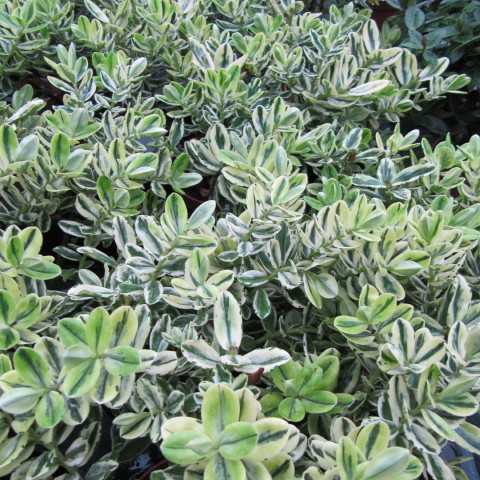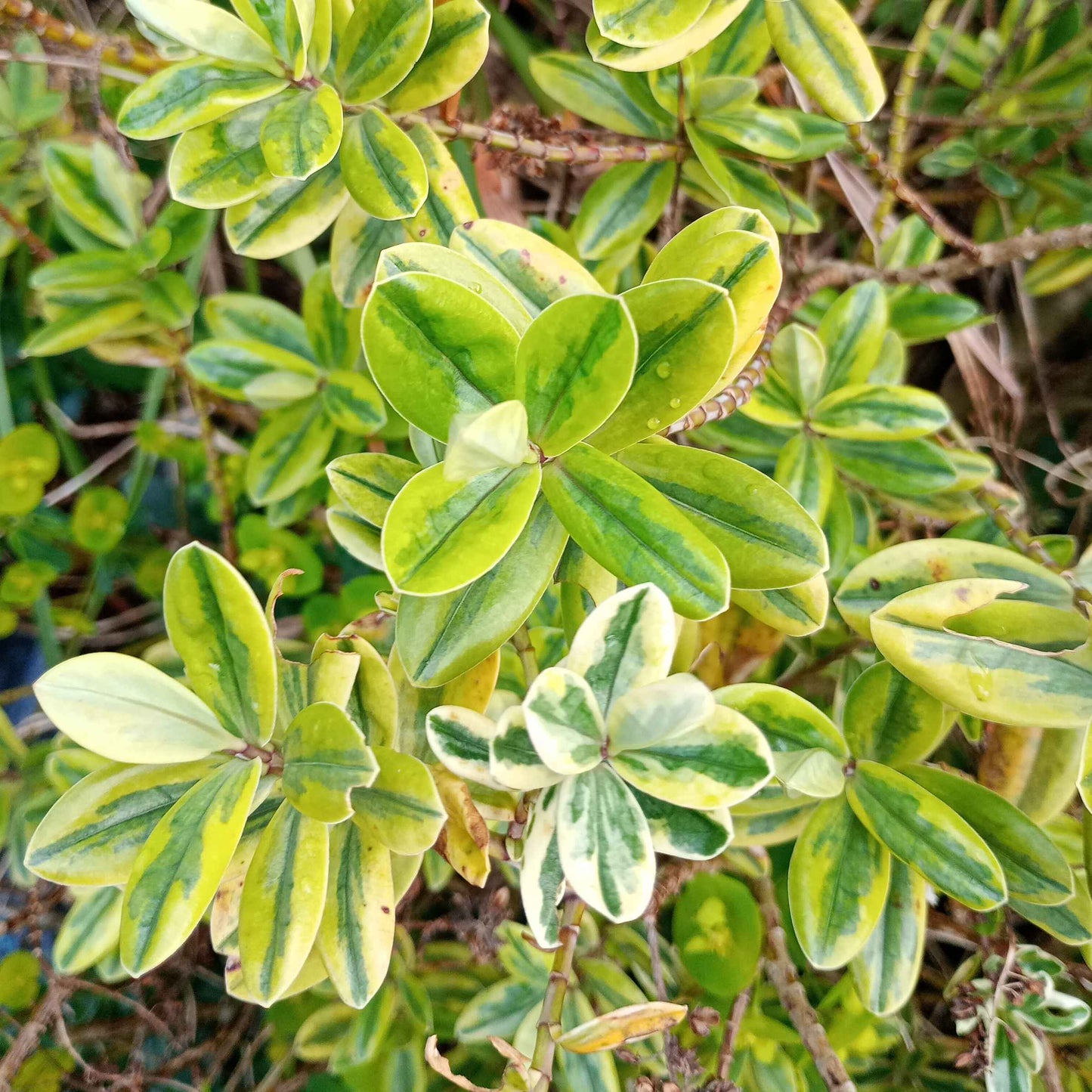Variegated Hebe
Variegated Hebe
Shrubby Veronica
5.0 / 5.0
(1) 1 total reviews
Available for dispatch from May
Couldn't load pickup availability
Organic Hebe 'Variegata' - Evergreen Shrub
A versatile, compact evergreen shrub prized for its cream-edged foliage and late-season flowers. This reliable variety combines year-round structural interest with low maintenance requirements, making it an excellent choice for borders, containers, and coastal gardens.
Plant Features
A neat, rounded shrub reaching 60-90cm in height and spread. Small, glossy leaves are dark green with clear cream margins that remain bright throughout the year. The dense growth habit creates effective ground cover while maintaining an attractive domed shape.
Foliage
Leaves are arranged in opposite pairs along the stems, creating an orderly, textural effect. The variegation is stable and doesn't revert, providing consistent cream and green colouring that brightens shaded areas and illuminates neighbouring plants.
Flowers
Produces spikes of pale lilac-blue flowers in late summer through autumn. The blooms appear abundantly against the variegated foliage, providing valuable late-season colour and attracting pollinators when many other plants have finished flowering.
Growing Requirements
Plant in full sun to partial shade in well-draining soil. Tolerates coastal conditions and urban pollution. Protect from harsh winter winds in colder areas. Height and spread: 60-90cm.
Perfect Plant Partnerships
Create effective year-round plantings with:
- Euonymus fortunei for complementary variegation
- Carex 'Comans bronze' for contrasting texture
- Bergenia for winter interest
- Geraniums for summer colour
- Heuchera for foliage contrast
- Lavender angustifolia for summer harmony
Maintenance
- Trim lightly after flowering to maintain shape
- Remove any damaged growth in spring
- Protect from severe frost in inland gardens
- Mulch annually with organic matter
- Water regularly until established
- Suitable for container growing with good drainage
Garden Uses
- Low maintenance borders
- Coastal gardens
- Container specimens
- Small gardens
- Ground cover
- Modern minimalist designs
- Year-round structure
This hardy evergreen provides reliable structure and colour throughout the year, while requiring minimal maintenance. Its compact size and tolerance of various conditions make it particularly valuable for small gardens and containers. The combination of variegated foliage and late-season flowers extends its ornamental value well beyond that of standard evergreen shrubs.
RHS Award of Garden Merit winner for consistent performance in UK gardens. Particularly valuable in coastal areas and urban settings where tough, reliable plants are required
Plant care guide
Plant care guide
How do you plant shrubs & woody plants?
Dig a hole slightly larger than the rootball size, but no deeper. If it is a plant that likes to stay on the drier side (such as lavender), make the hole slightly shallower than the root ball so the surface of the rootball sits proud of the ground and use organic matter around the plant to stop water pooling on the base of the plant.
Water the hole and if the plant rootball doesn't seem moist pre-soak the hessian contained rootball until it is saturated (no more bubbles rise to the surface).
There is normally no need to add compost to the hole if you have an established garden with healthy plants already growing. If you have a newbuild property or poor growth to existing plans chances are that your whole flowerbed needs improving with organic matter.
Place the rootball in the hole. You can remove the hessian sacking it came in, or just remove the staple/twine and open the top once it's in the ground so the plant is free. The roots will easily grow through and the hessian will decompose. Back fill the surrounding area with the dug soil. Do not firm the soil down hard! Roots need air and water and hard compacted soil prevents them from getting both.
Once planted water the plant in well and then water again whenever the soil starts to dry out under the surface, being careful not to overwater.
Mulching with something like woodchips around the plant after watering will help the soil to retain the moisture in hot weather. The perennial's foliage will die off in the winter and the plant will regrow through the mulch in the spring!
When to plant woody plants in the UK?
Our plants can be planted out in the garden or in pots from spring, through the summer, to autumn. During dry weather and especially during the summer much closer attention needs to be given to watering in the first year. Our plants supplied in 6 cm pots they will benefit from being grown on in a protected area before planting out.
If planting in hot weather, cut the foliage and flowers back if they are large. Your new plant will not be taking up much water until established so may struggle if the leaves lose more water than the roots can absorb. For the strongest result do not allow to flower or at least to set seed in the first year.
Where to plant woody plants?
Check the plant info at the bottom of the page for the best place to position your new plant. If it prefers sun and you site it in a north facing flowerbed next to a wall don't expect it to thrive or flower.
Pay attention to the soil. if it is heavy clay, incorporate organic matter such as compost to the soil before planting your shrub, preferably to the whole flowerbed. This will improve the soil by buffering it's water and nutrient holding ability. It is preferable to not just plonk compost in the bottom of the hole as it will not improve the overall condition of the soil surrounding your new plant. Do not add a layer of gravel or grit to the bottom of the hole as this will merely cause the perched water table to be higher. It will not improve drainage.
How do you care for woody plants?
Cut back untidy or dead stems in the spring (you can leave the clippings on the flower bed to allow the nutrients to recycle into the soil).
Should woody plants be fertilised?
The vast majority of garden soils contain plenty of nutrients, but if your garden is in a newly built development there is a good chance a thin layer of topsoil has been added on top of infertile subsoil. if that is the case, compost, soil improver or well rotted manure can be spread on the flower bed and dug in, or alternatively for those short of time or energy, organic fertiliser such as our own special organic mix of bone meal, hoof and horn and vinaase that is an organic, sustainable alternative to the John Innes formula, can be sprinkled around the plant with some compost added to the planting hole. Shrubs that are vigorous may benefit from supplementary feeding too as they may deplete the soils nutrients.
Delivery £5 flat rate or FREE over £80 spend.
Delivery £5 flat rate or FREE over £80 spend.
I charge a flat rate of £5 for postage and packaging to all of Britain, including the Highlands and the Isle of Man, with free delivery for orders over £80. We are unable to send plants to Northern Ireland.
I use Royal Mail for our deliveries as they have the lowest carbon footprint per parcel delivered in the UK and actually tend to look after parcels rather than just chucking them over the nearest fence! This ensures that your plants will have the best care possible.
Please have a Safe Place set up if possible so your plants are not returned to the sorting office if no one is home to accept the delivery.
I try to dispatch plants twice a week and you will receive updates by text or email. In cases of extreme weather or if Royal Mail has a hiccup the delivery may be delayed but we'll keep you in the loop.
I'm unable to deliver to the Channel Islands or Northern Ireland.
The LAWNMOWER Guarantee
The LAWNMOWER Guarantee
Healthy plants & happy customers
Your plant will only be dispatched if I'm happy it is healthy. The nature of growing the plants in large troughs means that the root system will be trimmed before they are balled in hessian, and therefore, depending on the time of year, the top growth may also be trimmed to make sure the roots are able to supply the water and nutrients your new plant requires.
Pruning encourages new growth and this applies to roots as well so a pruned plant actually results in a stronger plant.
The LAWNMOWER guarantee.
If you're not happy with your plants for any reason, even if you've run them over with your lawnmower, just pop them in a box (the plants, not the mower!) and post them back to us within 1 year for a replacement or refund.
This does not affect your statutory rights.
For full details check out the Refunds and Returns Policy.
Sustainability
Sustainability
Eco-friendly business
Fed up with plants grown in plastic pots which are doused in herbicides and sprayed with synthetic chemicals by big nurseries who merrily burn through finite resources, fly plants in from abroad on jet planes, irresponsibly use peat and coir, kill any insect nearby with non-selective pesticides and generally only think of the bottom line?
So are we!
How we grow plants sustainably
Our plants are started in coldframes or inside our house, grown-on woodfibre pots or in reclaimed wooden troughs which are then carefully harvested and balled and burlapped (hessian wrap securing the rootball), before packing plastic free in a eco cardboard box from a certified B-corp carbon neutral supplier. Some plants are grown in 8cm woodfibre pots.
Sustainable and organic compost & fertiliser
Our Soil Association certified organic compost is bought in bulk without plastic bags from Dalefoot Compost, and consists of sheep wool, bracken and comfrey. This naturally feeds the plants for 12 months. If supplemental feeding is required we only use our own special blend of organic fertilisers (bone meal, hoof & horn and vinaase) which have been processed with solar energy.
Carbon Neutral business
The small amount of electricity we use is from renewable sources and we irrigate our plants with stored water we have harvested. Plus, we are using our house and land for more than one purpose, preventing further land use and utilising the sunk carbon cost of the building rather than creating more.
We have partnered with Carbon Neutral Britain to offset our emissions, and recognise that we are not in control of all parts of the supply chain so have fully offset scopes 1, 2 and 3 to take that in to account - so that's all emissions connected to our business, from the farts coming out of the back of the sheep, to the carbon dioxide from the delivery van outside your door.
We don't just offset and carry on, ALL the decisions we make work to reduce emissions - for instance we use Royal Mail to post our plants as they have by far the lowest carbon footprint per parcel delivered in the UK.
Veronica speciosa
View full details


Variegated Hebe arrived fit and well, I planted it in prepared place, it is now settling in nicely and looking healthy. Love this companies eco-friendly attitude to all things plant-wise.



